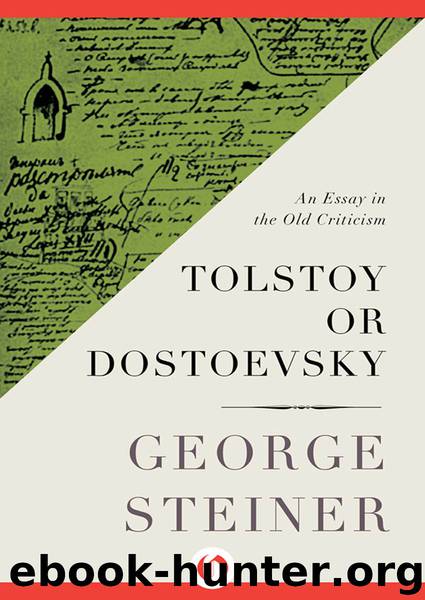Tolstoy or Dostoevsky by George Steiner

Author:George Steiner
Language: eng
Format: epub
Publisher: Open Road Integrated Media
VII
It used to be thought that the nineteenth-century novel, at least until Zola, had avoided the more scabrous and pathological aspects of erotic experience. Dostoevsky was cited as a pioneer in the revelation of that underworld of repression and “unnatural” lust which Freud has so richly opened to our awareness. But the facts are different. Even in the “high” novel we find masterpieces such as Balzac’s Cousine Bette and Henry James’s Bostonians treating precarious sexual themes with free intelligence. Stendhal’s Armance and Turgeniev’s Rudin are tragedies of impotence; Balzac’s Vautrin predates the Proustian invertis by nearly three quarters of a century and Melville’s Pierre is an extraordinary, though unrealized, foray into the indirections of love.
All this is doubly true of the “lower” novel, of the Gothic romans noirs and the immense outpouring of serialized horror and romance. Sadism, perversion, unnatural guilt, incest, the attendant machinery of abduction and mesmerism, were hackneyed motifs. The bookseller’s injunction to Balzac’s Lucien de Rubempré, when the latter first arrives in Paris, “write something in the manner of Mrs. Radcliffe,” was graven on the tables of literary law. Set plots involving distressed maidens, licentious oppressors, assassinations by gaslight, and redemption through love were held in readiness for the aspiring novelist. With genius he could turn them into The Old Curiosity Shop and La Fille aux yeux d’or; with talent, into Trilby and Les Mystères de Paris; with bare craft he could make of them one of the hundred thousand romans feuilletons now forgotten even by bibliographers. And it is because we have forgotten them that certain of Dostoevsky’s recurrent themes and dramatic situations appear to us as unique and pathological. In fact, his plots—considered purely as raw material or as stories that can be summarized—were no less dependent on a body of contemporary tradition and practice than were those of Shakespeare. To read into them matters of private obsession may be illuminating; but such a reading should follow, not precede, awareness of the public material at hand:
In many writers there are certain images or type-situations which recur openly or masked in most of their works. In the poems and dramas of Byron, for example, it is the hint of incest. As is well known, Dostoevsky alludes time and again to the sexual assault of an older man on a young girl or woman. To trace this theme through all of his writings and to show where it is present in covert symbolic forms would require a separate essay. It appears in Dostoevsky’s first novel, Poor Folk, where the orphaned Varvara is persecuted by Monsieur Buikov. It is hinted at in The Landlady, a tale in which the relations between Murin and Katerina are shadowed by a mysterious sin. In A Christmas Tree and a Wedding it takes the transparent guise of an old man’s attentions to an eleven-year-old girl whom he proposes to marry when she is sixteen. A similar motif is at work in that magnificent nouvelle, The Eternal Husband. The heroine of Netochka Nezvanova, a fragmentary novel, is morbidly attracted to her drunken stepfather.
Download
This site does not store any files on its server. We only index and link to content provided by other sites. Please contact the content providers to delete copyright contents if any and email us, we'll remove relevant links or contents immediately.
| African | Asian |
| Australian & Oceanian | Canadian |
| Caribbean & Latin American | European |
| Jewish | Middle Eastern |
| Russian | United States |
4 3 2 1: A Novel by Paul Auster(12290)
The handmaid's tale by Margaret Atwood(7685)
Giovanni's Room by James Baldwin(7199)
Asking the Right Questions: A Guide to Critical Thinking by M. Neil Browne & Stuart M. Keeley(5658)
Big Magic: Creative Living Beyond Fear by Elizabeth Gilbert(5618)
Ego Is the Enemy by Ryan Holiday(5297)
The Body: A Guide for Occupants by Bill Bryson(4978)
On Writing A Memoir of the Craft by Stephen King(4866)
Ken Follett - World without end by Ken Follett(4647)
Adulting by Kelly Williams Brown(4489)
Bluets by Maggie Nelson(4479)
Eat That Frog! by Brian Tracy(4440)
Guilty Pleasures by Laurell K Hamilton(4363)
The Poetry of Pablo Neruda by Pablo Neruda(4041)
Alive: The Story of the Andes Survivors by Piers Paul Read(3970)
White Noise - A Novel by Don DeLillo(3956)
Fingerprints of the Gods by Graham Hancock(3943)
The Book of Joy by Dalai Lama(3904)
The Bookshop by Penelope Fitzgerald(3783)
